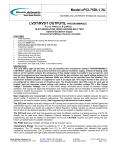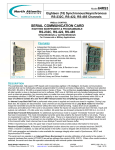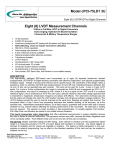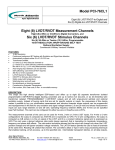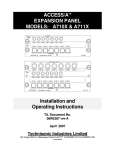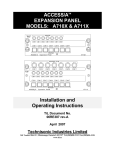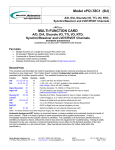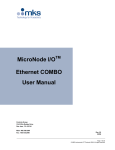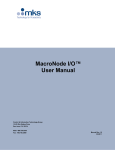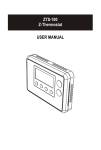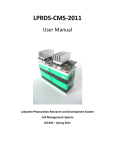Download 6V-LVDT/RVDT-1
Transcript
Model VME-64DL1 Eight (8) 3 or 4-Wire or Sixteen 2-Wire (16) Programmable Digital-to-LVDT/RVDT Channels LVDT Stimulus Channels Eight (8) 3 or 4-Wire or Sixteen (16) 2-Wire, Programmable 16 BIT RESOLUTION; WRAP-AROUND SELF TEST Optional Excitation Supply FOR COMMERCIAL AND MILITARY APPLICATIONS FEATURES: • • • • • • • • • • • • 16-bit resolution Continuous background BIT testing with Reference loss detection Power-On (POST) test Transformer isolated Stable output with temperature Watchdog timer and soft reset Either A32, A24 or A16 address Geographical addressing I/O via front panel, P2, or both No adjustments or trimming required Commercial or severe environment MIL Part number, S/N, Date code, & Rev. in non-volatile memory DESCRIPTION: This card offers sixteen (16) two-wire or eight (8) three/four-wire transformer isolated “PROGRAMMABLE” LVDT/RVDT outputs with wrap-around self test and optional excitation supply. Instead of buying cards that are set for specific outputs, the uniqueness of this design makes it possible to buy our generic card that can be programmed and reprogrammed in the field for any excitation and signal voltage between 2.0 and 28 volts. Operating frequency between 400 Hz and 10 KHz can be specified (see Part Number). One transformer isolated excitation is supplied for each A, B output pair. The output format of this card can be wired for either two-wire or three/four-wire. The transformation ratio (TR), same for each pair of outputs, sets the maximum output voltage with relation to the excitation voltage (TR = Max Output Voltage / Excitation Voltage). Use of a ratiometric design eliminates errors caused by excitation voltage variations. The outputs are stable with temperature and switching spikes are not noticeable. If geographical addressing is part of the overall system, this card will respond, otherwise the board dip switches will be activated to set base address. A watchdog timer is provided to monitor the processor. To simplify logistics, Part number, S/N, Date code, & Rev. are stored in non-volatile memory locations. Major diagnostics are incorporated to offer substantial improvements to system reliability because user is alerted (within 5 seconds) to channel malfunctions. This approach reduces bus traffic because the Status registers do not require constant polling. See Programming Instructions for further details. The (D2) test initiates automatic background BIT testing that compares the output of each channel against the commanded input to a test accuracy of 0.2 FS and monitors each Output and Excitation. A failure triggers an Interrupt (if enabled) and results are available in Status registers. Testing, requires no external programming, has no effect on the standard operation of this card and can be enabled or disabled via the bus. The (D3) test, starts a BIT test that generates and tests 20 different positions to a testing accuracy of 0.2 FS. Results can be read from Status registers. External reference is required. Testing requires no external programming, and can be Initiated or terminated via the bus. CAUTION: Outputs are active during this test. Check connected loads for possible interaction. The POST test, when enabled, will initiate a D3 test at power turn on. Conduction cooling which utilizes a thermal plane and wedge locks, can be specified (See P/N.) A stiffener improves vibration response. Both sides of the board can be conformal coated (See P/N.) All “E” boards are burned in for 24 hours and cycled from -40°C to +85°C. North Atlantic Industries, Inc. 110 Wilbur Place, Bohemia, NY 11716 631.567.1100/631.567.1823 (fax) www.naii.com / e-mail:[email protected] 05/19/10 Cage Code: 0VGU1 64_DL1_A001_Rev_6.9 Page 1 of 8 SPECIFICATIONS: Resolution: Linearity: Output Format: 16 bits (.001526% FS) 0.1% FS for .2 <= TR <= 2.0 (.05% FS available at a specified frequency and TR) Configurable for either 3/4-wire or 2-wire.Transformer isolated. Output voltage will vary directly with excitation. Output voltage: ±24 Vrms ±1% at no load. Transformer isolated. Load: With output voltages from 2.0 to 20.0 Vrms: 10 kΩ min. With output voltages from 20 to 28.0 Vrms: 15 kΩ min. Short circuit protected. Regulation: 2% max. Excitation: 2.0 to 28 Vrms. Transformer isolated. Frequency (excitation): 360 Hz to 10 KHz, Phase Shift (input to output): 3° max Phase shift (A/B): 0.5°. Excitation (each) Z in: 50 KΩ min. VME Data transfer: Data transfers within 200 ns Interrupts: Interface implements a single Interrupt capability. One of seven priority lines can be selected. Power: +5 VDC ±5% at 0.35 A ±12 VDC ±5% at 0.5 A Temperature, operating: “C” 0°C to +70°C, “E” -40°C to +85°C (See part number) Temperature, storage: -55°C to +105°C Size: 6U (9.2” height), 4HP (0.8”) width; 233.4 mm x 20.3 mm x 160 mm deep REFERENCE: Optional. (See part number). 2.0-28 Vrms programmable (resolution 0.1 Vrms). Accuracy ±2%. 360 Hz to 10 kHz ±1% with 1 Hz resolution. 10% max. No load to full load. 5 VA max. at 40° min. inductive. Voltage: Frequency: Regulation: Output power: Principal of Operation (LVDT): Typically the primary is excited by an ac source, causing a magnetic flux to be generated within the transducer. Voltages are induced in the two secondaries, with the magnitude varying with the position of the core. Usually, the secondaries are connected in series opposition, causing a net output voltage of zero when the core is at the electrical center. When the core is displaced in either direction from center the voltage increases linearly either in phase or out of phase with the excitation depending on the direction. 2 WIRE (1 CHANNEL) 2 WIRE (2 CHANNEL) OR (IN-PHASE) EXCITATION EXCITATION 10.0 V (USUAL LVDT CONFIGURATION) Example uses 10Vrms t t Vb 5.0 V Va 3 WIRE A = Va B = Vb A = Va EXCITATION EXCITATION 4 WIRE B = Vb 0.0 V POSITION -FS O +FS Va+Vb=10V Va+Vb=10V Va-Vb=-10V Va-Vb=0V Va=0V Va=5V Vb=10V Vb=5V Va+Vb=10V Va-Vb=10V Va=10V Vb=0V POSITION = (Va- Vb) / (Va+Vb) North Atlantic Industries, Inc. 110 Wilbur Place, Bohemia, NY 11716 631.567.1100/631.567.1823 (fax) www.naii.com / e-mail:[email protected] 05/19/10 Cage Code: 0VGU1 64_DL1_A001_Rev_6.9 Page 2 of 8 I/O CONFIGURATION: The VMEbus interface will respond to A32:D16, A24:D16 and A16:D16 DTB cycles. A32 mode: Unit responds to address modifiers 0A, 0D, 0E and 09. Base address can be set anywhere in the 4 Gigabyte address space on 512 byte boundaries (legacy cards DOM 0848 and earlier were 256 byte boundaries). A24 mode: Responds to address modifiers 3A, 3D, 3E and 39. Base address can be set anywhere in the 16 Megabyte address space on 512 byte boundaries (legacy cards DOM 0848 and earlier were 256 byte boundaries). A16 mode: Responds to address modifiers 2A, 2D, 2E and 29. Base address can be set anywhere in the 64 K byte address space on 512 byte boundaries (legacy cards DOM 0848 and earlier were 256 byte boundaries). Geographical Addressing: When Geographical Addressing is enabled (see P/N), the card will respond to address modifier 2Fh for A24 Address mode, where the 5 Msb’s of the A24 address are the 5 bits defined by the slot in VME back plane. The Card can optionally be interrogated at 2Fh to determine resource requirements and available functionally. Using the address modifier 2Fh, the following need to be written to the card: 1) the base address the card should to respond to 2) the address modifier (A16, A24, A32) 3) then enable the card. For example : If the card is in slot # 10 the 5 Msb’s are 01010 so the address of the CSR registers are : 0101 0 111 1111 1111 xxxx xxxx or 57FFxx h ( xx is CSR register offset) Write to address 57FF63 h, the A31 – A24 base address bits , for example 01h Write to address 57FF67 h, the A23 – A16 base address bits, for example 02h Write to address 57FF6B h, the A15 – A8 base address bits, for example 04h Write to address 57FF6F h the address modifier you wish to respond to shifted up 2 bits , for example 28h( 0A<< 2 ) Then Write to address 57FFFBh , 10h to enable the card. The card will now respond to the base address ( 010204 in the example ) and address modifier ( 0A in example) programmed. The base address and address modifier can be changed at any time. MEMORY MAP 00 Position Data Ch.1A read/write 28 Wrap-around Ch. 3A read 50 2-3/4 Wire Mode 02 Position Data Ch.1B 04 Position Data Ch.2A 06 read/write read/write 2A Wrap-around Ch. 3B read 52 Status, Excitation read/write 2C Wrap-around Ch. 4A read 54 Status, Test read Position Data Ch.2B read/write 2E Wrap-around Ch. 4B read 56 Status, Signal read 08 Position Data Ch.3A read/write 30 Wrap-around Ch. 5A read 58 Interrupt Level read/write 0A Position Data Ch.3B read/write 32 Wrap-around Ch. 5B read 5A Interrupt Vector read read 0C Position Data Ch.4A read/write 34 Wrap-around Ch. 6A read 5C Active channels read/write 0E Position Data Ch.4B read/write 36 Wrap-around Ch. 6B read 5E read/write 10 Position Data Ch.5A read/write 38 Wrap-around Ch. 7A read 60 Test (D2) verify read/write 12 Position Data Ch.5B read/write 3A Wrap-around Ch. 7B read 62 POST test read/write 14 Position Data Ch.6A read/write 3C Wrap-around Ch. 8A read 64 Freq. read/write 16 Position Data Ch.6B read/write 3E Wrap-around Ch. 8B read 66 Eo read/write Save read/write Test Enable 18 Position Data Ch.7A read/write 40 TR Ch.1 read/write 68 1A Position Data Ch.7B read/write 42 TR Ch.2 read/write 6A Watchdog timer 1C Position Data Ch.8A read/write 44 TR Ch.3 read/write 1E Position Data Ch.8B read/write 46 TR Ch.4 read/write 6C Soft reset 6E Part number 20 Wrap-around Ch. 1A read 48 TR Ch.5 read/write 70 S/N read/write write read read 22 Wrap-around Ch. 1B read 4A TR Ch.6 read/write 72 Date code read 24 Wrap-around Ch. 2A read 4C TR Ch.7 read/write 74 Rev level read 26 Wrap-around Ch. 2B read 4E TR Ch.8 read/write North Atlantic Industries, Inc. 110 Wilbur Place, Bohemia, NY 11716 631.567.1100/631.567.1823 (fax) www.naii.com / e-mail:[email protected] 76 Outputs, ON/OFF 78 Board Ready 05/19/10 Cage Code: 0VGU1 read/write read 64_DL1_A001_Rev_6.9 Page 3 of 8 REGISTER BIT MAP Active channels 2-wire or 3/4-wire Test Enable Status, Signal Status, Excitation Status, Test Outputs, ON/OFF D15 Ch.8B X X X X Ch.8B 1A&B D14 Ch.8A X X X X Ch.8A 2A&B D13 Ch.7B X X X X Ch.7B 3A&B D12 Ch.7A X X X X Ch.7A 4A&B D11 Ch.6B X X X X Ch.6B 5A&B D10 D9 D8 Ch.6A Ch.5B Ch.5A X X X X X X X X X X X X Ch.6A Ch.5B Ch.5A 6A&B 7A&B 8A&B D7 Ch.4B 8A/B X 8A&B 8A&B Ch.4B X D6 Ch.3A 7A/B X 7A&B 7A&B Ch.3A X D5 Ch.3B 6A/B X 6A&B 6A&B Ch.3B X D4 Ch.3A 5A/B X 5A&B 5A&B Ch.3A X D3 Ch.2B 4A/B D3 4A&B 4A&B Ch.2B X D2 Ch.2A 3A/B D2 3A&B 3A&B Ch.2A X D1 Ch.1B 2A/B X 2A&B 2A&B Ch.1B X D0 Ch.1A 1A/B X 1A&B 1A&B Ch.1A X PROGRAMMING INSTRUCTIONS: At Power ON or system reset, all parameters are restored to last saved setup and if POST is enabled, a D3 test is initiated. Active channels: Set the bit, corresponding to each channel to be monitored during BIT testing, in the Active Channel register. “1”=active; “0”=not used. Omitting this step will produce false alarms because unused channels will set faults. Save Setup: The current setup can be saved by writing 5555h to the Save register. This register will automatically clear to 00h when the save is completed. (within 5 seconds). When save is elected, all parameters are saved, however, any parameter can be changed at will. To restore factory shipped parameters, write AAAAh to the Save register followed by system reset. Note: After a Save or Restore, poll the Save register and do not perform any other operation until the Save register is equal to “0”. Enter Interrupt requirements into the Interrupt Register as an 8 bit binary number. 0= no interrupt; 1-7 indicates priority levels. Any error will latch status register and trigger an Interrupt. When Interrupt is acknowledged, additional errors will set another Interrupt. Reading will unlatch registers. Now, let us consider what happens when a status bit changes before registers are read. For example, if a signal loss was detected and latched into registers and subsequent scans find that the signal was reestablished, then this status change will be held in background until registers are read. After reading, registers will be updated with the background data within 250ms. Allow 250 ms to scan all channels. Interrupt Vector: Write 16 bit word (0-255) to Interrupt Vector Register. Output ON/OFF: Set the corresponding bit for the channel pair (A and B) to be Enabled or Disabled in the Output ON/OFF Register: Factory default is DISABLED “1” = Output Enabled, “0” = Output Disabled Example: To enable Channel 1 and disable the rest -> register value = 8000h. 2-wire or 3/4-wire mode: Set the bit corresponding for each output channel pair (A & B) in the 2-3/4 Wire Mode Register. Setting the bit to “0” => 3/4 wire mode; Setting the bit to “1” => 2 wire mode. When setting a channel pair to 2-wire mode both channels, A & B of that number pair will be set for 2-wire. Position Output: Enter the position as a 2’s complement number in the corresponding Position Ch. Data Register within the range of -1.00 < Position < (+1.00 – lsb). In 3/4-wire mode, position is written only to the A channel of that number pair. The B channel register is ignored. In 2-wire mode the A and B channels are set independently. Factory default: POSITION = 0 Calculate using: register value = POSITION * 32768 Example: For a POSITION = -0.5 -> register value = -0.5 * 32768 = -16384 (0xC000) Example: For a POSITION = 0.75 -> register value = 0.75 * 32768 = 24576 (0x6000) The Output voltages in 3/4-wire mode are related to the position by: Va = Excitation Voltage * TR * [ Position/2 + 0.5 ] Vb = Excitation Voltage * TR * [ 1 – ( Position/2 + 0.5 ) ] The Output voltage in 2-wire mode is related to the position by: V = Excitation Input * TR * Position North Atlantic Industries, Inc. 110 Wilbur Place, Bohemia, NY 11716 631.567.1100/631.567.1823 (fax) www.naii.com / e-mail:[email protected] 05/19/10 Cage Code: 0VGU1 64_DL1_A001_Rev_6.9 Page 4 of 8 Transformation Ratio (TR) for (A&B): Set the TR for the corresponding channel in the TR Register using the following formula: TR register value = TR * 1000 Example: For a TR of 0.5 -> TR register value = 0.5 * 1000 = 500 (0x01F4) The valid range of TR is: 0.00 <= TR <= 2.00. NOTE: TR * Input Voltage must be less than 28V Factory default is TR = 1000 for 1:1. Optional Excitation Output Voltage: Set the Excitation output voltage in the Eo Register using the following formula: Exc. Out voltage register value = V * 10 Example: For a Excitation output voltage of 7V The valid range is: 0.0 <= V <= 28.0 -> register value = 7 * 10 = 70 (0x0046) Optional Excitation Output Frequency: Set the Excitation output frequency programmed directly in Hz in the Eo Register. Example: For a Excitation Output Frequency of 1000Hz -> register value = 1000 (0x03E8) The valid range is: 360 <= F <= 10KHz It is recommended that user program the required frequency before setting the output voltage. POST: Will initiate the D3 test upon Power-On, if POST is enabled and saved. Enable by writing “1” to POST register. Disable, by writing “0” to POST register and then save setup. Test Enable (D2): Writing “1” to the D2 bit of the Test Enable Register initiates automatic background BIT testing that compares the output of each channel with the commanded input to a testing accuracy of 0.2% FS. Results can be read from the Test Status register. A “0” deactivates this test. This test is totally transparent to the user, requires no external programming, has no effect on the standard operation of this card and can be enabled or disabled via the bus. The card will (every 30 seconds) write 55h to the Test (D2) verify register when (D2) is enabled. User can periodically clear to 00h and then after 30 Seconds read the Test (D2) verify register again to verify that background bit testing is activated. In addition, each Excitation input and signal output is continually monitored. Any failure triggers an Interrupt (if enabled) and the results are available in the Signal and Excitation Status Registers. Test Enable (D3): Writing “1” to D3 bit of the Test Enable Register initiates a BIT test that generates and tests 20 different inputs, to a testing accuracy of 0.2% FS and monitors Excitation and Signal loss. Test cycle takes about 45 seconds and results can be read from Status Registers. Excitation is required and outputs must be ON. The testing can be terminated at any time by writing “0” to D3 bit of the Test Enable Register. CAUTION: During the (D3) test, the outputs are active. Verify that changing those outputs will not effect connected equipment. To read status: Read the Signal Status Register for signal loss, Excitation Status Register for excitation loss, and Test Status Register for accuracy. Test: “1” Accuracy OK; “0” failed; Status: “1” Exc./Sig. On, “0” Exc./Sig. loss. Read Wrap-Around Angles: Wrap-around positions are read from the Wrap-around Channel Registers. Each enabled D/L channel is measured prior to the transformer output and can be read from the corresponding Wraparound Channel Register. The generated result is a 16-bit binary word (or 16-bit 2’s compliment word) that represents position. The data is available at any time. Note: In 3/4-wire mode, only channels 1-8A need to be read. Soft reset: (Level sensitive): Writing a “1” to the Soft Reset Register initiates and holds software in reset state. Then, writing “0” initiates reboot. It takes 650 ms before card starts initialization sequence and about 15s to complete initialization. This function is equivalent to a power-on reset Watchdog Timer: This feature monitors the Watchdog Timer Register. When it detects that a code has been received, that code will be inverted within 100 µsec. The inverted code stays in the register until replaced by a new code. The user should look for the inverted code, after 100 µsec, to confirm that the processor is operating. Part Number: Read as a 16-bit binary word from the Part Number Register. A unique 16 bit code is assigned to each model number. Serial Number: Read as a 16 bit binary word from the Serial Number Register. This is the serial number of that particular board. North Atlantic Industries, Inc. 110 Wilbur Place, Bohemia, NY 11716 631.567.1100/631.567.1823 (fax) www.naii.com / e-mail:[email protected] 05/19/10 Cage Code: 0VGU1 64_DL1_A001_Rev_6.9 Page 5 of 8 Date Code: Read as decimal number from the Date Code Register. Four digits represent YYWW (Year, Year, Week, Week). Revision Level: Example 15 14 13 12 11 10 0 0 0 0 1 1 DSP Rev 1.1 9 0 8 7 6 5 0 0 0 1 FPGA Rev 3 4 1 3 0 2 1 0 0 0 1 PC Rev 1 Board Ready: Poll register. Board is ready to be accessed only after you read “AA55.” Board is ready approximately 15 seconds after soft reset, or power on. Front panel Connectors: Mating connectors are not supplied. J1: DC37P; Mate: DC37S Pin Pin 37 Ch.1 A Lo. 15 Ch.2 B Lo. 19 Ch.1 A Hi. 33 Ch.2 B Hi. 18 Ch.1 B Lo. 32 Exc. 2A-B Hi 36 Ch.1 B Hi. 14 Exc. 2A-B Lo 35 Exc. 1A-B Hi. 31 Ch.3 A Lo. 17 Exc. 1A-B Lo. 13 Ch.3 A Hi. 34 Ch.2 A Lo. 12 Ch.3 B Lo. 16 Ch.2 A Hi. 30 Ch.3 B Hi. J2: DC37P; Mate: DC37S Pin 29 11 28 10 9 27 26 8 Exc. Hi 3A-B Exc. Lo 3A-B Ch.4 A Lo. Ch.4 A Hi. Ch.4 B Lo. Ch.4 B Hi. Exc. Hi 4A-B Exc. Lo 4A-B Pin 24 Ch.5 A Lo. 7 Ch.5 A Hi. 6 Ch.5 B Lo. 25 Ch.5 B Hi. 5 Exc. 5A-B Hi 23 Exc. 5A-B Lo 21 Ch.6 A Lo. 4 Ch.6 A Hi. Designation Ch.5 B Hi. Ch.5 B Lo. Exc. 1A-B Hi. Exc. 1A-B Lo. Exc. 2A-B Hi Exc. 2A-B Lo Exc. 3A-B Hi Exc. 3A-B Lo Exc. 4A-B Hi Pin 29a 28a 27a 25a 26a 19a 23a 19c 21c Pin 3 22 2 20 1 Ch.6 B Lo. Ch.6 B Hi. Exc. 6A-B Hi Exc. 6A-B Lo Chassis Pin 6 Ch.7 A Lo. 7 Ch.7 A Hi. 27 Ch.7 B Lo. 8 Ch.7 B Hi. 25 Exc. 7A-B Hi. 26 Exc. 7A-B Lo. 10 Ch.8 A Lo. 11 Ch.8 A Hi. Pin 31 12 29 30 37 35 17 Ch.8 B Lo. Ch.8 B Hi. Exc. 8A-B Hi Exc. 8A-B Lo Chassis Int. Exc. Out Hi Int. Exc. Out Lo P2 Connector: Pin Designation Pin Designation Pin 18c Ch.1 A Lo. 32c Ch.3 A Hi. 12a 22c Ch.1 A Hi. 26c Ch.3 B Hi. 16a 20c Ch.1 B Hi. 31c Ch.3 B Lo. 29c 24c Ch.1 B Lo. 18a Ch.4 A Lo. 27c 10c Ch.2 A Lo. 22a Ch.4 A Hi. 28c 14c Ch.2 A Hi. 20a Ch.4 B Hi. 30c 12c Ch.2 B Hi. 24a Ch.4 B Lo. 31a 16c Ch.2 B Lo. 10a Ch.5 A Lo. 32a 25c Ch.3 A Lo. 14a Ch.5 A Hi. 30a Do not connect to any undesignated pins. North Atlantic Industries, Inc. 110 Wilbur Place, Bohemia, NY 11716 Designation Exc. 4A-B Lo Exc. 5A-B Hi Exc. 5A-B Lo Exc. 6A-B Hi Exc. 6A-B Lo Exc. 7A-B Hi Exc. 7A-B Lo Exc. 8A-B Hi Exc. 8A-B Lo 631.567.1100/631.567.1823 (fax) www.naii.com / e-mail:[email protected] Pin Designation Pin Designation 1c Ch.6 A Lo. 15c Ch.8 A Hi. 2c Ch.6 A Hi. 13c Ch.8 B Hi. 3c Ch.6 B Hi. 17c Ch.8 B Lo. 4c Ch.6 B Lo. 1d Internal Exc. Out HI 11a Ch.7 A Lo. 2d Internal Exc. Out Lo 15a Ch.7 A Hi. 13a Ch.7 B Hi. 17a Ch.7 B Lo. 11c Ch.8 A Lo. 05/19/10 Cage Code: 0VGU1 64_DL1_A001_Rev_6.9 Page 6 of 8 CODE TABLE Code Frequency (I) 01 400 02 2.8k – 3.2k 03 2k 04 2.69k 05 1.9k – 2.8k 06 3k Notes Contact factory regarding code list addendum for other operating frequencies/characteristics. PART NUMBER DESIGNATION 64DL1 - X X X X X X – XX TOTAL NUMBER OF A & B CHANNELS 2 = 2 Channels* 4 = 4 Channels* 6 = 6 Channels* 8 = 8 Channels* CODE (See Code Table) ENVIRONMENTAL C = 0°C to +70°C E = -40°C to +85°C H = E With Removable Conformal Coating K = C With Removable Conformal Coating EXCITATION INPUTS C = One Common Input T = Individual Inputs OPTIONS 0 = None 9 = Custom Design (See Separate Spec) contact factory for other temperature requirements EXCITATION SUPPLY R = On-Board Excitation E = External Excitation MECHANICAL F = Front Panel I/O and P2 I/O P = P2 I/O only W = P With Wedgelocks A = VME64 with Blank Front Panel and P2 I/O only B = VME64 Front Panel with Front Panel I/O & P2 I/O D = VME64 with Blank Front Panel, Low profile extractors and P2 I/O only NOTE: * Channel density “N” specified for 3 or 4 –Wire Mode. Density doubles to “2N” when using 2-Wire Mode. North Atlantic Industries, Inc. 110 Wilbur Place, Bohemia, NY 11716 631.567.1100/631.567.1823 (fax) www.naii.com / e-mail:[email protected] 05/19/10 Cage Code: 0VGU1 64_DL1_A001_Rev_6.9 Page 7 of 8 Revision Page Revision Engineer Date 5.1 Added Code 7 GS 12/13/01 5.2 Reversed Register Map (76h) Output On/Off to D15-8=Ch1-8, D7-0=x (Don’t care) For 2-wire config., only 8 channels are available (not 16). Memory Map: 5Ah is read only, 58h is Interrupt Level. Output format of this card can be wired (not configured). GS 12/14/01 5.3 Memory Map 0x00->0x1c are Ch’s 1-8; Corrected J1 conn. pinout Ch6 Label “A” side. GS 12/20/01 5.4 Description, line 1, “sixteen” is actually “eight” (8) two-wire... GS 01/04/02 5.5 See code list addendum for descriptions of code 50 and above. Part Number: contact factory for other temperature requirements. Removed temp “M”. Non-volatile, not permanent memory. Save is R/W. GS 02/06/02 5.6 Removed Part Number “L” Option, VME64 front panel with Low profile extractors and with front panel I/O & P2 I/O. Front panel I/O interferes with extractors. GS 06/19/02 5.7 Update LARGE DL Graphic GS 06/27/02 5.8 Correct Polarity in Diagrams for Principles of LVDT Operation Standardized PN, Mech. Options List to FPWABD. Added support for 2 Wire mode: B Position Data and Wrap Around Registers as well as their function descriptions. Added Board Ready register. B channel support is provided with new mother-board DS1 rev D – almost considered model DS3/DL3. Added codes 5 and 6 (removed 7 as it is the same as 5 (see master code list) Read Wrap: In 3/4-wire mode, only channels 1-8A (not 1-6A) need to be read. Transformer Ration: TR register value = 0.5 * 1000 (not 100) Added Board Ready & Rev description. Removed Factory default from ¾-2 wire mode. Change TR default from 0 to 1000 (1:1). Deleted default from Ref Volt and frequency. Added “It takes 650ms before care starts initialization sequence and about 15s to complete initialization.” To Soft reset description Only for clarity, Va = Excitation Voltage * TR * [ Position/2 + 0.5 ], Vb = Excitation Voltage * TR * [ 1 – ( Position/2 + 0.5 ) ] Adds Output Voltage (+- 24 volt) spec., Corrects BIT Bit-Map. GS 06/28/02 GS 07/30/02 GS 08/13/02 GS 10/22/02 GS 10/25/02 GS 02/05/03 GS 07/22/03 GS 08/08/05 11/03/05 5.9 6.0 6.1 6.2 6.3 6.4 Description of Change 6.5 FOR COMMERCIAL AND MILITARY APPLICATIONS. Reference spec calls out 2-28V (not 115). 6.6 Corrected drawings in Principal of Operation LVDT (pg 2) FH / ars 6.7 Corrected “typo” P2 connector pinout; 19c, 21c, 17c FH / ars 12/05/05 6.8 New Address KL 04/24/07 6.9 Clarified address byte boundaries: from 256 to 512 byte boundaries; legacy cards DOM 0848 and earlier were 256 byte boundaries (pg. 3); Agile release. AS 05/19/10 North Atlantic Industries, Inc. 110 Wilbur Place, Bohemia, NY 11716 631.567.1100/631.567.1823 (fax) www.naii.com / e-mail:[email protected] 05/19/10 Cage Code: 0VGU1 64_DL1_A001_Rev_6.9 Page 8 of 8








